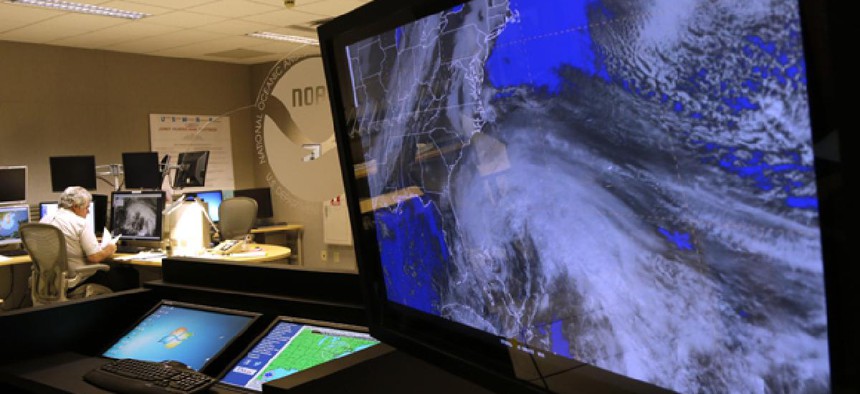
A satellite image of Hurricane Sandy is shown on a computer screen at the National Hurricane Center in Miami. Lynne Sladky/AP
Sequestration Could Jeopardize Upgrades to Life-Saving Weather Satellites
Aerospace industry again sounds alarm, pleas for full funding.
Executives from the companies that produce the nation’s weather satellites gathered on Capitol Hill Monday to showcase the multi-agency observation and forecasting technology systems that are threatened by tight budgets and sequestration.
The panel was assembled by the Aerospace Industries Association just days after the geospatial and orbital satellite systems currently slated for modernization were placed on the Government Accountability Office’s list of “high risk” programs. Also, acting Commerce Secretary Rebecca Blank this month said that because of the budget crisis, “significant and costly impacts” on satellites and other observational programs run by the National Oceanic and Atmospheric Administration were “certain.”
Frank Slazer, the AIA’s vice president for space systems, said the satellite programs, which are launched by NASA and coordinated with the Defense Department, “are pretty much woven into how we do operations.” He cited planning for the Desert Storm invasion of Iraq, to the raid that killed Osama bin Laden to forecasting of last October’s Superstorm Sandy. “It’s no longer just Tang and Velcro and other spinoffs of the past,” he said. “We’d be lost if we didn’t have these satellites.”
Eric Webster, vice president and director of weather systems at ITT Exelis, cited NOAA’s estimate that one-third of the U.S. gross domestic product is affected by data from more than 100 observation systems in the water, air and space. “The U.S. has more severe weather than any other nation,” he said, adding that 96 percent of data for global forecasts comes from satellites. “No one system can do it all, which is why NOAA requires a system of systems.”
Describing the satellite-based “imagers and sounders” in geospatial orbit (22,300 miles above the Earth) and polar orbit (520 miles), Webster explained that while funding looks pretty certain for the current systems, the next generation of systems is at risk. They will offer such improvements as higher-resolution images, wider coverage, and more rapid retrieval -- offering downloads that currently take 30 minutes in as few as five, he said. “We’re in a crucial place in both programs, and any reductions in funding that delays the program launch is a real concern.”
Cory Springer, director for weather and environment at Ball Aerospace & Technologies Corp., said, “Earth observations are absolutely necessary and crucial to everything we do,” including the military’s ability to conduct operations safely and effectively underwater, on the sea, in the air and in space. “There is a synergy between NASA and Defense missions,” he said.
Agency interdependence was also underlined by Jon Malay, director of civil space and environment programs for Lockheed Martin, who noted that the three daily satellite global readings are a shared responsibility. The early-morning data read is done by the Pentagon, the mid-morning reading by European partners, and the early afternoon one by NOAA, he said.
The appropriation for the satellite program “resides in the non-defense discretionary category, but it is defense and it isn’t discretionary,” Malay added, stressing the importance of the data to commercial flights, agriculture, risk management and insurance, tourism, and public health.
He described a calculation NOAA released using data that successfully forecast the 2010 “Snowmageddon” storm that hit the mid-Atlantic states. By removing the early-afternoon data from the five-day weather forecast issued at the time, the calculation forecast a storm much less severe than what actually occurred. “Our forecasts are pretty darn good,” Malay said, noting the increasing frequency of tornados, floods and blizzards. “We know that weather will do damage, the question is how many lives will it take.”
In contemplating sequestration, Lockheed has “received no specific guidance from NASA,” on how to adjust its satellite system contract, Malay said.
“Congress has an understanding of the importance of observation satellite programs,” said Springer, pointing to language for full funding in a 2013 authorization bill. But the uncertainty surrounding the long-term upgrades won’t be known until the fiscal 2014 budget is released, he said.
The satellite program also received some funding in the recently enacted relief bill for victims of Sandy, said Webster, a former congressional staffer. But the potential for a long-term gap in satellite coverage in coming years could still materialize if funding is delayed, he said. “Congress gets it, but they have the issues of the debt and deficit,” he said. Under sequestration, however, NOAA would have to decide which pieces of the program’s $900 million budget would be cut.







